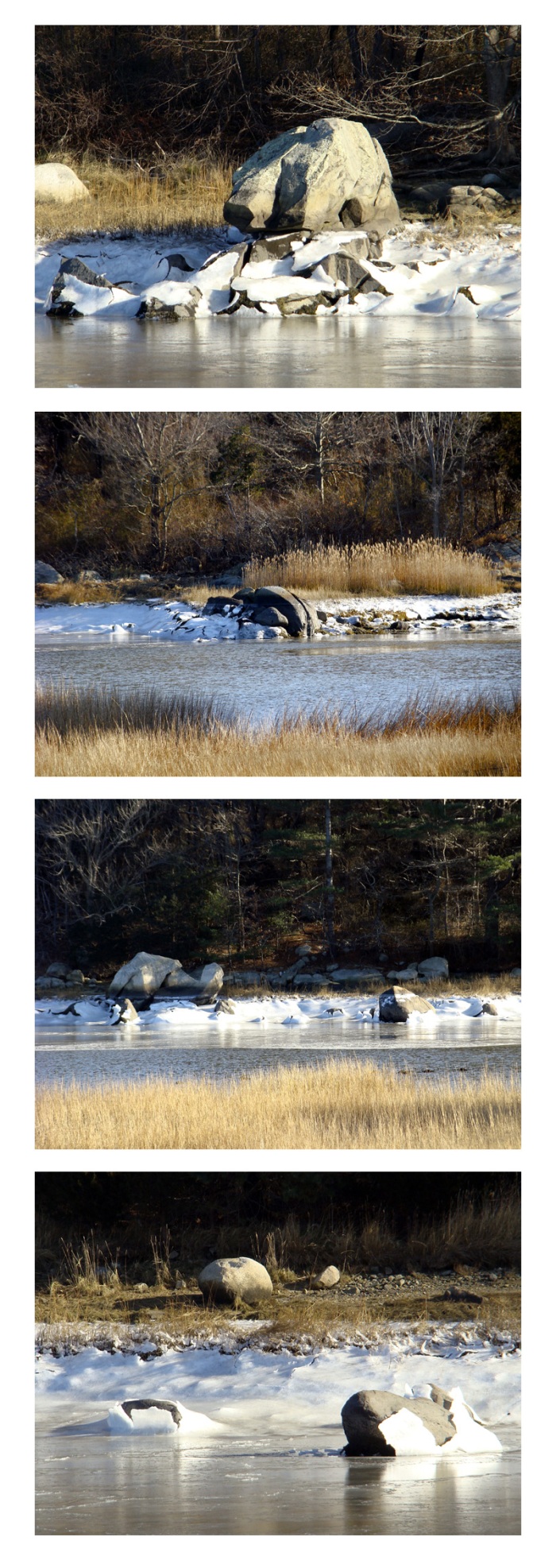After a lifetime of collecting, studying, admiring and climbing on rocks, I have made an exciting petrologic discovery that answers that nagging, ages old question, especially in New England: “Why do rocks seem to multiply and grow?” I have discovered that rocks, like turtles, hatch from shells. In the photos here you can see some of them in the process of emerging from their shells. Also, rocks grow, and like snakes they shed their skin as they grow. You can also see some of the more mature rocks here shedding their skin.
Rocks mate in the spring and the young hatch in the winter when the cold speeds up their metabolism, after varying lengths of gestation periods depending upon the type of rock (whether igneous, sedimentary, or metamorphic), ranging from 10 to 100 years. That is why we have more rocks in New England than Florida, for example, where it is warmer year round. Of course there are rocks everywhere because we had an ice age about 20,000 years ago, which resulted in an explosive birth rate of rock populations around the globe. Since that time however, the warmer climates have lost and not been able to replace their rock populations, which are now mostly sand, while we in the Northeast always have plenty of fresh new rocks to move around, and build stonewalls, foundations and gardens with. Cape Ann seems to have the ideal climate for rock propegation and growth.
E.J. Lefavour


Dear E.J.
Thanks for my “Chuckle of the Day.” You have a great imagination…speaking of which, if you look at the large boulder in the back of your last photo, he reminds me of a giant turtle advancing towards the camera, with one large webbed foot in front. I can even see two beady eyes. (But it looks like a dinosaur took a chuck out of his back.)
LikeLike
Love it!
LikeLike
Thanks E.J.
Now we know!
LikeLike
Daw.. they’re so cute when they’re babies!
LikeLike
Perfect deadpan. It’s like all the Did You Knows up to this point have been a set up for this one. I’m a stone person too.
LikeLike
That’s fun, EJ.
LikeLike
Did you learn this at the Colorado School of Mines? 🙂
LikeLike
This explains so much, and makes me feel so relieved that I finally understand pet rocks! Some time after adopting a few small rocks many years ago, I discovered they were gone. Now I know that when I lined them up on the porch they were getting their first fling at freedom, and when they matured they left for bigger pastures, returning as it were, to their roots in the soil. Of course ‘petrology’ is the root of the word ‘pet’ as applied to rocks. Etymology always comes through! Thank you for this thoughtful and validating article. My guilt at ‘losing’ my rocks is gone; I didn’t abandon them, they left home. Again I repeat, “How relieved I am!”
LikeLike
Patty, I never heard of the Colorado School of Mines, but any school that has a school mascot named Blaster the Burro and studies rocks has to be cool. Maybe they’d be interested in learning about my discovery. BTW, Great interview with Karen Ristuben on the Cultural District!
Gail, I believe that pet rocks are bred in captivity and are a domesticated variety of the wild rocks we see around Cape Ann. I’m sure they instinctively know they belong with the earth and were probably thrilled to gain their freedom, and by now may have turned feral.
LikeLike
How I love our ole “Yankee humor…………..thanks folks for making me smile today.
LikeLike
One of my jobs in the spring was to till my father’s garden and lug the rocks out. Year after year more rocks grew in that garden. No other way to explain it. That was on the other Cape and there is way more starting material here but the growth rates of the baby rock nursery in the garden seems similar.
LikeLike
lol!!! hilarious and written so well! 🙂 There is a rock family reunion in what I would love to someday call my backyard.
LikeLike